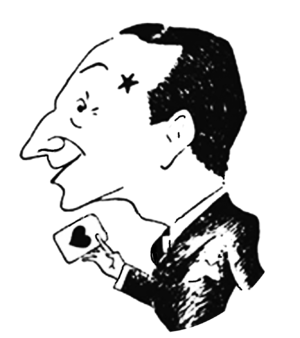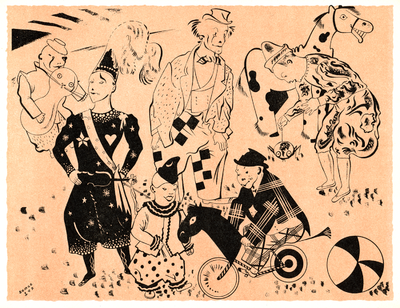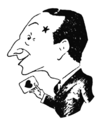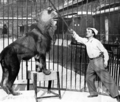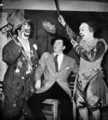Serge
From Circopedia
Contents
Circus Chronicler, Graphic Artist
By Dominique Jando
Serge (1901-1992) was, from the 1930s up to the late 1970s, a well-known figure of the Parisian entertainment scene, not as an actor—although his flamboyant personality would certainly have made one think he was a thespian—but as a journalist and chronicler, author of many books, and a prolific illustrator. He was also an exuberant circus enthusiast, and most of his work concerned the circus and its close cousin, the music-hall (vaudeville or variety).
He was born Maurice Féaudierre in Paris, France, on December 14, 1901, to Jules Victor Féaudierre, a paint merchant, and his wife Marguerite, née Bauvé. It is not clear where his nom de plume, Serge, came from. All his life, Serge was a Parisian through and through, although he had a great affection for London, a city to which he dedicated one of his books, Londres secret et ses fantômes (1946), which chronicled the great city as it was just after the end of WWII. He traveled often to see circus and variety shows all over Europe. His wife, née Blanche Barbas, was a dentist.
Serge, who was outgoing and always ready to strike a conversation with people he had just met if they shared his interest for (or worked in) his favorite performing art, had many friends in the circus world. He was also fascinated by the world of Gypsies ("Bohémiens," in French), but his books, whatever their subject, always returned to the circus. During his long period of professional activity, there was no Parisian circus or music-hall event to which Serge was not invited, and his ebullient personality always made his presence difficult to ignore—and always welcome!
The Circus Poet
He published his articles in several newspapers and magazines, notably Le Crapouillot, a popular pre-war satirical magazine, and Comœdia and Les Nouvelles Littéraires, two important literary journals. But over the years, his radio broadcasts truly made him a household name, at a time when radio personalities, before the development of television, were extremely popular. His radio shows, Panorama des Variétés, Les Jeux du Cirque, Jeudi au Cirque, Gens du Voyage, Circoradio, etc., and his inimitable style (written and spoken) particularly rich in flourishes, as well as his high-pitched voice reminiscent of a fairgrounds' barker, made him immediately recognizable: His voice and style merged perfectly with the rousing circus music that accompanied his enthusiastic descriptions and comments. An entire generation of French children and adults had been led to love the circus by the sheer magic of Serge's voice.
Serge's graphic style as an artist was also immediately recognizable; his drawings, done in a post-art nouveau style full of fantasy and poetry, gave a thrilling image of the circus that actually matched his writing style. Serge was not an occasional artist: His paintings had won him a Grand Prix at the Exposition Internationale de Paris in 1937. He illustrated many books and articles, including his own books for which he always used his own photographs and drawings; most notably, his Panorama du Cirque (1944) was published in a case containing eighty plates of his circus drawings. He was also an amateur magician and ventriloquist, and an amateur lion trainer.Although he knew and understood the circus, its people, and its history very well, his books, even though they contained quantities of historical tidbits and fascinating anecdotes, could not be truly considered the works of a true circus historian, not even his very entertaining Histoire du Cirque (1947). As circus historian Dominique Denis pointed out, Serge was first and foremost a poet of the circus: "His style, recognizable from the first line, immerses the reader in a dimension that has nothing to do with the mundane. Captain of an intergalactic vessel, Serge takes us to worlds of glitter, ribbons, plumes, smiles..." For anyone who likes circus, reading his prose, in French, is a pure delight—but unfortunately for non-francophone readers, it would lose too much in translation. His illustrations, however, match very well the poetry of his prose, and can be appreciated universally.
In 1954 Serge created, with a group of French journalists, writers, artists and circus personalities, the Académie du Cirque et du Music-Hall ("Circus and Variety Academy"), of which he was the president. The Academy published a collective book, Histoire du Music-Hall (1954), to which Serge contributed illustrations, but after this initial burst of activity, it soon faded into oblivion. Serge passed away in Paris on October 16, 1992, at age ninety-one; he had long retired from public life by then, but he had not been forgotten by an entire generation of French (and mostly, Parisian) circus enthusiasts: They mourned their most colorful and exhilarating bard!
Suggested Reading
- Serge, Vive le Cirque — Phénomènes, acrobates, clowns, fauves (Paris, Marcel Seheur éditeur, 1930)
- Serge, Rue du monde (Paris, Marcel Seheur éditeur, 1931)
- Serge, Le Monde du Cirque (Paris, Librairie des Champs-Élysées, 1939)
- Serge, Panorama du Cirque — with 80 illustration plates by the author (Paris, Éditions Arc en Ciel, 1944)
- Serge, La Route des Cirques (Paris, A.B.C., 1945)
- Serge, L'île aux merveilles (Paris, Librairie des Champs-Élysées, 1945)
- Serge, Londres secret et ses fantômes (Paris, Éditions Ergé 1946)
- Serge, Panache indien (Paris, Éditions Heracleia, 1946)
- Serge, Histoire du Cirque (Paris, Librairie Gründ, 1947)
- Serge, Magie des Bohémiens (Paris, Librairie des Champs-Élysées, 1950)
- Serge, Le vagabond de Paris (Paris, Librairie des Champs-Élysées, 1951)
- Serge, Gitanes et Toréros (Paris, Éditions Baudinière, 1952)
- Serge, Amar, Roi du Cirque (Paris, Éditions de Paris, 1952)
- Serge, Paris, mon cœur (Paris, Éditions Seghers 1959)
- Serge, Clowns de Paris (Paris, Éditions des Presses du Temps Présent, 1959)
- Serge, La grande histoire des Bohémiens (Paris, Éditions Karolus, 1963)
